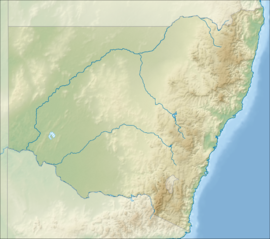Nightcap National Park
|
Nightcap National Park New South Wales |
|
|---|---|
|
IUCN category II (national park)
|
|

Protesters Falls, Terania Creek, Nightcap National Park
|
|
| Nearest town or city | Lismore |
| Coordinates | 28°32′38″S 153°17′35″E / 28.54389°S 153.29306°ECoordinates: 28°32′38″S 153°17′35″E / 28.54389°S 153.29306°E |
| Established | 22 April 1983 |
| Area | 81 km2 (31.3 sq mi) |
| Managing authorities | NSW National Parks & Wildlife Service |
| Website | Nightcap National Park |
| See also | Protected areas of New South Wales |
The Nightcap National Park is a national park located in the Northern Rivers region of New South Wales, Australia. The 8,080-hectare (20,000-acre) park was created in April 1983 and is situated 35 kilometres (22 mi) north of Lismore. The national park is classed by the IUCN World Commission on Protected Areas as Category II and is part of the Shield Volcano Group of the World Heritage Site Gondwana Rainforests of Australia inscribed in 1986 and added to the Australian National Heritage List in 2007.
The Nightcap Range is located within the national park.
The park is on the south-eastern edge of the Mount Warning erosion caldera. Creating features of gullies, ridges and a massif of peaks that form the eroded remnants of the Tweed shield volcano. The tallest peak at Nightcap is Mount Burrell also known as Blue Knob with an elevation of 933m above sea level. The Nightcap Range is mostly situated in the park and is a spur off the Great Dividing Range.
The basalt and rhyolite lava that once flowed from the Tweed volcano (known as Mount Warning) that had erupted over 23 million years ago, has produced various vegetation communities. On soil with a rhyolitic base is warm temperate rainforest that cover much of the park and the nutrient rich basalt soil produce sub-tropical rainforest.
Nightcap has the highest rainfall in NSW with rain exceeding 2500mm per annum. The mean temperature ranges from 19.1 °C to 29.7 °C; the region can experience high humidity and temperatures can get close 40 °C. High rainfall events and storms of cyclonic strength can occur during the summer.
Several Aboriginal communities inhabited the region and a spiritual connection to the land, these communities include the Nganduwal, Galibal, Githabul and Widjabal. The Widjabal people lived at Nightcap Range for at least 4000 years. The region is the base for the Bundjalung nation. Historically the park provides rock shelters for the Aboriginal people. The parks landscapes, plants and animals feature prominently in Aboriginal culture and dreaming stories and there are sacred sites of cultural significance in the area.
...
Wikipedia

